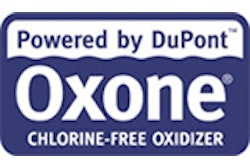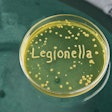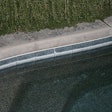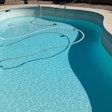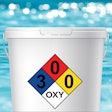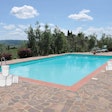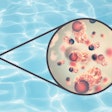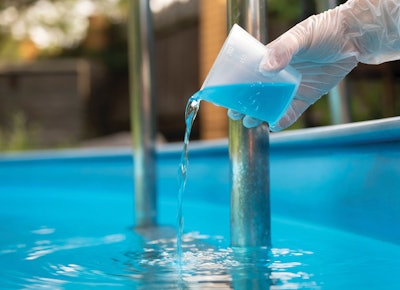
Maintaining the water quality in swimming pools requires a multifaceted approach that will need to work together to maintain healthy and clear water. Typically, a lot of attention is paid to the sanitation and oxidation of water in swimming pools, but these alone may not be able to maintain water clarity and quality in pools. Therefore, pools may require using certain specialty chemicals, typically referred to as pool maintenance products (PMPs), to maintain clarity and quality. These PMPs complement the pool’s sanitizer system to improve and maintain water clarity. Some of the main PMPs used regularly are algicides, clarifiers, metal sequestering agents, and filter cleaners.
Specialty devices may include ozone generators and UV systems, among others. There are many types of devices, but this article will only cover a few of the popular specialty devices currently being used in pools. PHTA fact sheets that cover some of these devices in detail are available on the PHTA website at www.phta.org/standardsand-codes/fact-sheets/water-quality.
This article provides some basic and general information on different specialty chemicals and certain devices that will help to maintain a healthy and clear pool.
EXAMPLES OF POOL MAINTENANCE PRODUCTS & DEVICES
Specialty chemical treatment products and devices work together to maintain pool clarity as well as maintain a healthy pool, in combination with the use of an EPAregistered sanitizer and oxidizers. These products are designed to correct certain pool maintenance issues and maintain a healthy and clear pool. Pool maintenance products are designed to complement the primary sanitizing system. Each PMP is designed to solve a particular issue in pool water quality.
Specialty chemicals and devices must be used in conjunction with an EPAregistered sanitizer to maintain a healthy and clear pool. They should not be used alone or in combination with other PMPs or devices as the only means of treatment in pools to maintain a sanitized and clear pool. And, as always, be sure to follow the manufacturer’s instructions on the product label.
- Algicides — Used to kill algae. They can enhance the effectiveness of oxidizers to kill and
prevent the growth of algae. They are typically used as maintenance or remedial treatment to maintain an algae-free pool. Besides chlorine, there are many different algicide products, but typically, algicides are either quat, polyquat, or metalbased (copper) formulations. Other chemistries, such as bromine and ammonia-based products, are also used to kill and control algae in pools. - Clarifiers — Typically used in conjunction with the filtration system to remove small particles that create haze in pools. Clarifiers conglomerate small, unfilterable particles into larger particles that are easily captured. Alternatively, these chemicals can tighten the spaces within the filter media enabling the small particles to be captured more effectively. Made from different chemical formulations, clarifiers are either polymeric, saltbased, such as alum, or natural species, such as chitosan.
- Filter Cleaners — Designed to clean and remove the insoluble particles that were captured inside the filter. Filter cleaners come in different formulations that can either be acidic, basic, and/ or surfactant-based products. All filter cleaners work either by dissolving and/ or dislodging the insoluble particles from the filter media, in which case they are removed by backwashing or rinsing the filter media with water.
- Metal Sequestering Agents — Chemicals, in both liquid and solid form, intended to bind unwanted metal ions, e.g., copper, iron and other heavy metals, in pool water and limit their oxidation. Liquid sequestering agents temporarily protect pool surfaces and do not physically remove appreciable amounts of metal from the water, as the size of the sequestered metal is too small to be captured by the pool filter. Liquid sequestering agents are continuously destroyed by the primary sanitizer and secondary disinfection system. Therefore, in addition to the regular treatment dose, frequent additional “maintenance doses” of these chemicals are required to keep the dissolved metals from oxidizing and staining the pool surface. Alternatively, the sequestering agent can be in solid form, collecting and removing the metal ions as they pass over the material during normal circulation of the water. For more information, refer to the fact sheet “Metals and Metal Staining” on the PHTA website at www. phta.org/standards-and-codes/factsheets/water-quality.
- UV Light Systems — Used as either secondary disinfection system, supplemental treatment system, and/or water conditioning device. These systems operate in a certain wavelength, depending on their usage. For more information, refer to the fact sheet “Ultraviolet (UV) Light Pool Systems” on the PHTA website at www. phta.org/standards-and-codes/factsheets/water-quality.
- Ozone Generators — Used as either a secondary disinfection system or supplemental treatment system. These devices inject ozone gas into the pool water, providing supplemental oxidation that works with oxidizers to maintain clarity, amongst other benefits it provides. Ozone can also act as a micro-flocculant and anti-foaming agent. For more information, refer to the fact sheet “Ozone Generating Systems” on the PHTA website at www. phta.org/standards-and-codes/factsheets/water-quality.
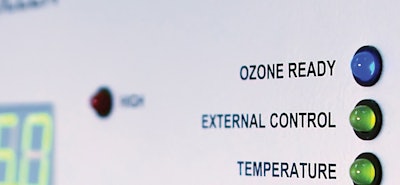 Ozone generators, which inject ozone gas into the water, can be used as a secondary disinfection system or supplemental treatment system. Ozone can also act as a micro-flocculant and anti-foaming agent.
Ozone generators, which inject ozone gas into the water, can be used as a secondary disinfection system or supplemental treatment system. Ozone can also act as a micro-flocculant and anti-foaming agent.
Specialty chemicals and devices are used in many different aquatic environments. Typically, these products are used depending on the nature of the water quality being addressed, or to boost the efficacy of the primary sanitizing systems. Auxiliary devices, such as ozone generators, and supplemental and secondary UV light systems, may not be required for all pool installations; but they are used to enhance the water quality and sanitation in pools. PMPs are typically used either as maintenance or remedial treatments, specially designed to address specific water quality issues in pools. For example, clarifiers are added either on a maintenance basis or as remedial treatment to help the filter remove small, insoluble particles.
PRECAUTIONS
- Special attention should be paid to make sure filter cleaners are disposed of properly after they are either rinsed or backwashed from the filters. Refer to the federal, state, and/or local regulations for proper disposal of these chemicals.
- Use of personal protective equipment such as gloves and safety glasses are highly encouraged when using chemicals in any capacity, especially when filter cleaners are being used.
- High concentrations of algicides could create issues such as foaming, skin irritation, or staining in pools. Always use in accordance with the manufacturer’s instructions.
- High concentration of algicides may also interfere with some test methods.
- Pool professionals and/or licensed electricians should install and service electrical pool equipment.
- All safety precautions should be taken when using these products. Labels and manufacturer’s instructions should be followed very carefully.
- Ensure the PMP or device is compatible with the sanitizing system being used in the pool.
- PMPs should be stored properly according to the label instructions and typically must be stored in a cool and dry place at all times.
Comprehensive information for maintaining water quality in swimming pools and spas can be found in the ANSI/ APSP/ICC-11 2019 American National Standard for Water Quality in Public Pools and Spas.
REFERENCES
1. Recreational Water Quality Committee “Ozone Generating Systems” Fact Sheet, Pool & Hot Tub Alliance, 2018, www.phta. org/pub/?id=08BE1D3F-1866-DAAC-99FB6D2EE8EC8073
2. Recreational Water Quality Committee “Ultraviolet (UV) Light Pool Systems” Fact Sheet, Pool & Hot Tub Alliance, 2020, www. phta.org/pub/?id=4597727A-1866-DAAC-99FBA1F828C30B61
3. Recreational Water Quality Committee “Metals and Metal Staining” Fact Sheet, Pool & Hot Tub Alliance, 2020, www.phta. org/pub/?id=1D3342A3-1866-DAAC-99FB6F1B5C809B62
4. Recreational Water Quality Committee “Polyhexamethylene Biguanide (PHMB) Sanitizer” Fact Sheet, Pool & Hot Tub Alliance, 2011, www.phta.org/pub/?id=08DB34BE-1866- DAAC-99FB-BF1CCC5E52ED
5. ANSI/APSP/ICC-11 2019 American National Standard for Water Quality in Public Pools and Spas, Pool and Hot Tub Alliance, Alexandria, Virginia, www.phta.org
The PHTA Recreational Water Quality Committee
Jody O’Grady, Taylor Technologies, Inc., Chair
Terry Arko, HASA, Inc.
Kevin Cox, NSF International
Dr. James Egan, LaMotte Company
Philip Escobedo, Fluidra
Rich Gallo, Pure Swim, Inc.
Kenneth Gregory, Pentair Water Quality Systems
Dr. Christopher M. Kareis, Axiall, A Westlake Company
Dr. Joseph Laurino, Periodic Products, PHTA Board of Directors Liaison
Touraj Rowhani, Sigura
Terry Snow, TLS Pool Service / Independent Pool and Spa Service
Association (IPSSA) Representative
Dr. Roy Vore, Vore & Associates LLC John Weber, BioLab, Inc.
Voting Alternates:
Jeff Gaulding, BioLab, Inc.
Ellen Meyer, Sigura
Consultants:
Jana Auringer, Pebble Technology International
Beth Hamil, MicroPlasma Ozone Technologies, Inc.
David Oxley, Pinellas Aquatic Consultation and Education
Dr. Stanley Pickens, Swim-Chem Consulting Services, LLC
This article first appeared in the April 2022 issue of AQUA Magazine — the top resource for retailers, builders and service pros in the pool and spa industry. Subscriptions to the print magazine are free to all industry professionals. Click here to subscribe.


























